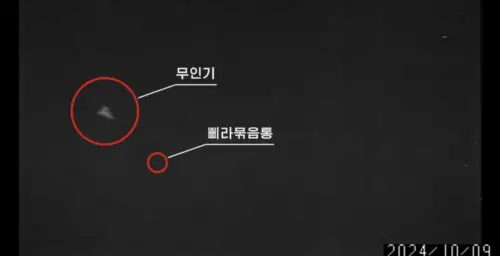The Korean Peninsula has long been a flashpoint of geopolitical tensions, with North and South Korea locked in a volatile standoff that periodically flares into threats of military conflict. In the latest development, North Korea has accused South Korea of flying drones over its capital, Pyongyang, to scatter anti-regime propaganda leaflets, sparking fierce rhetoric from Pyongyang and heightening concerns about the region’s fragile security situation. North Korea’s Foreign Ministry warned of an imminent and potentially violent response, claiming its military is now prepared for “all means of attack” to safeguard its sovereignty.
This latest confrontation threatens to destabilize a region already teetering on the edge, with North Korea issuing increasingly aggressive statements and South Korea responding with military readiness and joint exercises with the United States. The allegations of drone intrusions, though unconfirmed by South Korean authorities, have added fuel to an already combustible relationship, potentially escalating into a broader conflict with dire implications for regional and global security.
A Prelude to Escalation?
North Korea’s Foreign Ministry claims that South Korean drones breached its airspace three times in early October, including over Pyongyang itself, an assertion that has not been independently verified. Pyongyang described these actions as a violation of its “sacred” sovereignty and an attack on its security. The statement from North Korea was unmistakably belligerent, warning that the “safety lock on our trigger has now been released,” and threatening to respond with force if further incursions occur.
While North Korea’s rhetoric is often hyperbolic, its threats cannot be dismissed outright. The regime, led by Kim Jong Un, has repeatedly emphasized its willingness to use its nuclear arsenal if it perceives an existential threat. Though this latest outburst does not explicitly mention nuclear retaliation, the specter of North Korea’s atomic weapons looms over any military confrontation. Given North Korea’s history of sudden and often unpredictable military actions, the risk of escalation into open conflict is real.

South Korea’s Response: Cautious but Resolute
In response to North Korea’s accusations, South Korea has adopted a tone of cautious defiance. South Korea’s Joint Chiefs of Staff stated they could not verify North Korea’s claims but firmly rejected Pyongyang’s provocations. They emphasized that “all responsibility for the recent series of events lies with North Korea” and warned that any threat to South Korean citizens would be met with a “resolute and fierce response.”
The South’s statement also pointed to North Korea’s recent psychological warfare campaign, in which the North has sent thousands of balloons carrying trash and propaganda materials over the border into South Korea. This bizarre tactic, which many in South Korea have interpreted as an attempt to stoke fear and resentment, has only deepened the animosity between the two nations.
Furthermore, South Korea’s leadership, in close coordination with the United States, has bolstered its defensive posture through joint military exercises and enhanced intelligence-sharing. These drills, which North Korea regularly condemns as provocative, are a clear signal that Seoul is prepared to counter any military aggression. The alliance with the U.S. remains a cornerstone of South Korea’s defense strategy, and the ongoing presence of U.S. strategic assets in the region—such as advanced fighter jets and missile defense systems—adds a layer of deterrence.
The Role of the United States: A Delicate Balance
The United States plays a critical role in the security dynamics of the Korean Peninsula. Washington’s military alliance with Seoul has been a cornerstone of regional stability since the Korean War, and the presence of nearly 30,000 U.S. troops in South Korea serves as a deterrent against North Korean aggression. However, this security arrangement also makes the U.S. a direct participant in any potential conflict.
In recent months, North Korea has repeatedly condemned the joint military exercises between the U.S. and South Korea, referring to them as acts of “confrontational hysteria.” Pyongyang’s military leadership has vowed to respond by bolstering its defensive capabilities, including cutting off road and rail links to the South and fortifying its border areas with new defensive structures.
For Washington, the challenge is balancing its commitment to South Korea’s defense with the need to avoid provoking North Korea into further escalation. Diplomatic efforts to engage North Korea have largely stalled in recent years, particularly after the collapse of denuclearization talks between Kim Jong Un and former U.S. President Donald Trump. As tensions mount, the Biden administration faces the difficult task of navigating a path that avoids both military confrontation and the appearance of passivity.
A Growing Risk of Conflict
The security situation on the Korean Peninsula has far-reaching implications for the broader region, including Japan, China, and even Russia. Japan, as a close ally of the United States and a potential target for North Korean missiles, is particularly vulnerable to the fallout from any escalation. In recent years, Tokyo has increased its defense spending and sought closer security ties with both the U.S. and South Korea in response to North Korea’s missile tests and nuclear ambitions.
China, North Korea’s most significant ally and economic lifeline plays a complex and often opaque role in the peninsula’s security dynamics. While Beijing has repeatedly called for calm and the resumption of diplomatic talks, it has also shielded North Korea from the full brunt of international sanctions, maintaining trade links and providing critical economic support. Any escalation of hostilities between North and South Korea would put China in a difficult position, forced to balance its desire for regional stability with its longstanding support for Pyongyang.
Russia, though less directly involved, has also expressed concern about rising tensions. Moscow has cultivated closer ties with North Korea in recent years, particularly in the context of its deteriorating relations with the West. Russia has condemned U.S. and South Korean military exercises in the region, framing them as provocations that exacerbate tensions.

A Potential Flashpoint for Global Conflict
The current situation on the Korean Peninsula is a potent reminder of how localized tensions can have global consequences. Any conflict between North and South Korea would almost certainly draw in the United States, and potentially other major powers like China and Russia, raising the stakes significantly. The presence of nuclear weapons on both sides of the divide adds a layer of risk, as even a conventional military clash could quickly spiral into a catastrophic confrontation.
The Korean Peninsula sits at the crossroads of key global trade routes, and a conflict there would have significant economic repercussions. Disruption to shipping lanes, particularly those passing through the strategically vital Strait of Malacca, would impact not only regional economies but global supply chains.
A Delicate Balance of Power
The accusations of drone flights over Pyongyang and the resulting threats from North Korea have once again brought the security situation on the Korean Peninsula into sharp focus. While both sides have so far avoided direct military confrontation, the potential for miscalculation remains high. The stakes for regional and global security are immense, as any conflict in this volatile region could quickly escalate into a broader international crisis. As North Korea continues to ramp up its rhetoric and military readiness, the need for cautious diplomacy and robust deterrence has never been more critical.
The path forward will require careful management from all sides—South Korea, North Korea, the United States, and other regional powers like China and Japan—to prevent a dangerous slide toward conflict. The Korean Peninsula, with its long history of tension and conflict, remains one of the most precarious flashpoints in the world, and the coming months will be critical in determining whether peace or conflict prevails.



